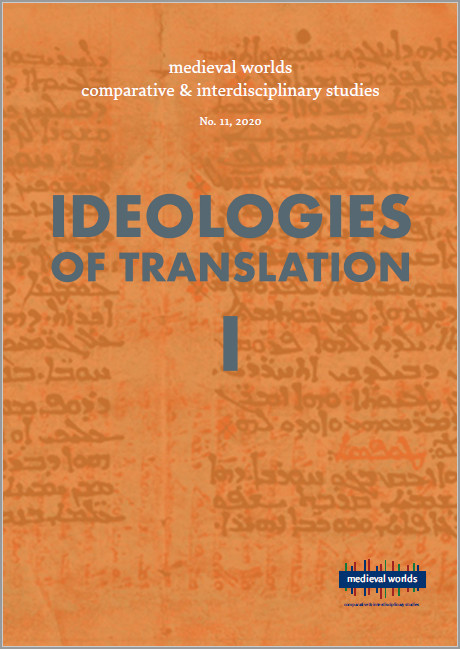 |
 |
Walter POHL – Andre GINGRICH (Eds.)
medieval worlds • no. 11 • 2020
Beatrice Gruendler,
Jan J. van Ginkel,
Rima Redwan,
Khouloud Khalfallah,
Isabel Toral,
Johannes Stephan,
Matthew L. Keegan,
Theodore S. Beers,
Mahmoud Kozae,
Marwa M. Ahmed
S. 241 - 279 doi: 10.1553/medievalworlds_no11_2020s241
Verlag der Österreichischen Akademie der Wissenschaften doi: 10.1553/medievalworlds_no11_2020s241
Abstract:
In this collective article, members of the AnonymClassic project discuss various aspects of their work on the textual tradition Kalīla and Dimna. Beatrice Gruendler provides a general introduction to the questions being considered. This is followed by a number of short essays in specific areas, organized into three categories: codicology, literary history and theory, and the digital infrastructure of the project. Jan J. van Ginkel summarizes the challenges involved in editing the Syriac versions of Kalīla and Dimna; Rima Redwan explains the AnonymClassic team’s approach vis-à-vis the transcription and textual segmentation of Arabic manuscripts; Khouloud Khalfallah follows this with an overview of the types of data that are recorded for each codex that is integrated into the project; Beatrice Gruendler, in a second contribution, shares some preliminary results from the analysis of interrelationships among manuscripts; and Rima Redwan, also in a second contribution, discusses the sets of illustrations, or »image cycles«, that are found in many copies of Kalīla wa-Dimna. Moving into the realm of literary history and theory, Isabel Toral poses a range of questions relating to the status of Kalīla and Dimna, as (arguably) anonymous in authorship and as a fundamentally translated book; Johannes Stephan explores the references to Kalīla wa-Dimna found in various medieval Arabic scholarly works; and Matthew L. Keegan confronts the problem of the genre(s) to which Kalīla wa-Dimna might be assigned and the exceptional »promiscuity« of the text. The last section of the article, on digital infrastructure, contains two contributions: Theodore S. Beers describes a web application that the team has created to facilitate the consultation of published versions of Kalīla and Dimna, and, finally, Mahmoud Kozae and Marwa M. Ahmed offer a more comprehensive discussion of the digital tools and methods – specialized and in some cases developed »in-house« – on which the AnonymClassic project relies.
2020/06/30 15:53:33 Object Identifier:
0xc1aa5576 0x003ba1d6
Rights:All rights reserved.For questions regarding copyright and copies please contact us by email.
medieval worlds provides a forum for comparative, interdisciplinary and transcultural studies of the Middle Ages. Its aim is to overcome disciplinary boundaries, regional limits and national research traditions in Medieval Studies, to open up new spaces for discussion, and to help developing global perspectives. We focus on the period from c. 400 to 1500 CE but do not stick to rigid periodization.
medieval worlds is open to submissions of broadly comparative studies and matters of global interest, whether in single articles, companion papers, smaller clusters, or special issues on a subject of global/comparative history. We particularly invite studies of wide-ranging connectivity or comparison between different world regions.
Apart from research articles, medieval worlds publishes ongoing debates and project and conference reports on comparative medieval research.
Table of Contents
Ideologies of Translation, I
Instead of an Introduction: Medieval Europe Translated
Pavlína Rychterová
Technologies of Translation
The Byzantine Imperial Chancery and its Language Policy from Justin II to Leo III
(Sixth-Eighth Centuries): From Latin to Greek
Christian Gastgeber
Translation as Interpretation: Translating Galen’s Polysemous Term Physis into Arabic
Elvira Wakelnig
Between Languages, Genres and Cultures: Diego Collado’s Linguistic Works
Jan Odstrčilík
Politics of Translation
The Latin Talmud and the Extension of Papal Jurisdiction over Jews
Alexander Fidora
»For they did not change their language« (MekhY Pischa 5):
On the Early Medieval Literary Rehebraicisation of Jewish Culture
Constanza Cordoni
Cultures of Translation
The Tibetan Translation of the Indian Buddhist Epistemological Corpus
Pascale Hugon
Translation as Commentary in the Sanskrit-Old Javanese Didactic
and Religious Literature from Java and Bali
Andrea Acri and Thomas M. Hunter
Project Report
An Interim Report on the Editorial and Analytical Work of the AnonymClassic Project
Beatrice Gruendler, Jan J. van Ginkel, Rima Redwan, Khouloud Khalfallah, Isabel Toral, Johannes Stephan, Matthew L. Keegan, Theodore S. Beers, Mahmoud Kozae, Marwa M. Ahmed
|




 Home
Home Print
Print
 References
References
 Share
Share
